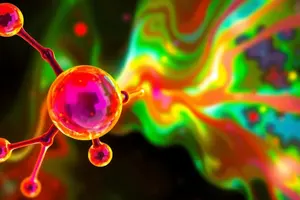Podcast
Questions and Answers
Explain the purpose of infrared spectroscopy and its applications.
Explain the purpose of infrared spectroscopy and its applications.
Infrared spectroscopy is used to study and identify chemical substances or functional groups in solid, liquid, or gaseous forms. It can be used to characterize new materials or identify and verify known and unknown samples.
What instrument is used to conduct the method of infrared spectroscopy, and what does it produce?
What instrument is used to conduct the method of infrared spectroscopy, and what does it produce?
The method of infrared spectroscopy is conducted with an instrument called an infrared spectrometer (or spectrophotometer) which produces an infrared spectrum.
How is an IR spectrum visualized, and what are the typical units used in IR spectra?
How is an IR spectrum visualized, and what are the typical units used in IR spectra?
An IR spectrum can be visualized in a graph of infrared light absorbance (or transmittance) on the vertical axis vs. frequency, wavenumber or wavelength on the horizontal axis. Typical units of wavenumber used in IR spectra are reciprocal centimeters, with the symbol cm−1.
What are the common units of IR wavelength, and how are they related to the wavenumber?
What are the common units of IR wavelength, and how are they related to the wavenumber?
What are the three ways in which the interaction of infrared radiation with matter can be measured in infrared spectroscopy?
What are the three ways in which the interaction of infrared radiation with matter can be measured in infrared spectroscopy?
Flashcards are hidden until you start studying
Study Notes
Infrared Spectroscopy
- Infrared spectroscopy is a analytical technique used to identify and study the molecular structure of organic and inorganic compounds
- It is based on the principle that molecules absorb specific frequencies of infrared radiation corresponding to their vibrational modes
Instrumentation
- The instrument used to conduct infrared spectroscopy is called an infrared spectrometer
- The spectrometer produces an infrared spectrum, which is a graph of the intensity of infrared radiation absorbed or transmitted versus the wavelength or wavenumber
Visualizing the IR Spectrum
- The IR spectrum is typically visualized as a graph of transmittance (%T) or absorbance (A) versus wavelength (λ) or wavenumber (ν̃)
- The x-axis represents the wavelength or wavenumber, while the y-axis represents the intensity of absorption or transmittance
Units of IR Wavelength and Wavenumber
- The common units of IR wavelength are micrometers (μm) or nanometers (nm)
- Wavenumber is the reciprocal of wavelength, typically expressed in reciprocal centimeters (cm⁻¹)
- Wavelength and wavenumber are related as follows: ν̃ = 10⁷ / λ (nm)
Interaction of IR Radiation with Matter
- The interaction of infrared radiation with matter can be measured in three ways: • Transmission: measuring the intensity of radiation transmitted through a sample • Absorption: measuring the intensity of radiation absorbed by a sample • Reflection: measuring the intensity of radiation reflected from a sample
Studying That Suits You
Use AI to generate personalized quizzes and flashcards to suit your learning preferences.




